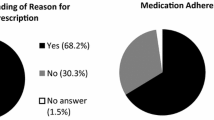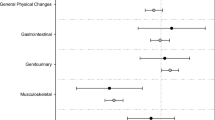Abstract
The treatment of chronic illness, and the prevention of disease progression and recurrence, often involve long-term adherence to prescription medications in breast cancer. Despite the survival benefit of endocrine therapies, nonadherence remains high. In this study, we examined barriers to and facilitators of endocrine therapy adherence among women with breast cancer (n = 1371). Participants currently taking tamoxifen or aromatase inhibitors were recruited from Dr. Susan Love Research Foundation’s Army of Women® Registry. Participants responded online to open-ended and close-ended questions about thoughts, feelings, and behaviors relevant to endocrine therapy. Two weeks later, women were invited to complete a second online questionnaire regarding current endocrine therapy adherence. Approximately one-third (36 %) of participants reported the presence of factors that make endocrine therapy difficult; reporting any barrier to medication adherence was significantly associated with nonadherence (P < 0.001). In addition, 31 % of women used one or more strategies to maintain their motivation to adhere and the use of cognitive self-talk (e.g., thoughts regarding endocrine therapy efficacy) was related to higher adherence. Hierarchical linear regressions revealed a significant behavioral barrier × behavioral facilitator interaction (P < 0.05); participants who endorsed a behavioral barrier in the absence of a behavioral facilitator reported the lowest adherence. Findings suggest that a sizeable minority of women face barriers to taking endocrine therapy, which are associated with nonadherence.

Adapted Morisky Adherence Scale
Similar content being viewed by others
References
DeSantis CE, Lin CC, Mariotto AB, Siegel RL, Stein KD, Kramer JL, Jemal A (2014) Cancer treatment and survivorship statistics, 2014. Cancer J Clin 64:252–271
Dunnwald LK, Rossing MA, Li CI (2007) Hormone receptor status, tumor characteristics, and prognosis: a prospective cohort of breast cancer patients. Breast Cancer Res 9:R6
Burstein HJ, Temin S, Anderson H, Buchholz A, Davidson NE, Gelmon KE, Griggs JJ (2014) Adjuvant endocrine therapy for women with hormone receptor-positive breast cancer: American society of clinical oncology clinical practice guideline focused update. J Clin Oncol 32:2255–2269
McCowan C, Shearer J, Donnan PT, Dewar JA, Crilly M, Thompson AM, Fahey TP (2008) Cohort study examining tamoxifen adherence and its relationship to mortality in women with breast cancer. Brit J Cancer 99:1763–1768
Makubate B, Donnan PT, Dewar JA, Thompson AM, McCowan C (2013) Cohort study of adherence to adjuvant endocrine therapy, breast cancer recurrence and mortality. Brit J Cancer 108:1515–1524
Hershman DL, Shao T, Kushi LH, Buono D, Tsai WY, Fehrenbacher L, Kwan M, Neuge AI (2011) Early discontinuation and non-adherence to adjuvant hormonal therapy are associated with increased mortality in women with breast cancer. Breast Cancer Res Tr 126:529–537
Murphy CC, Bartholomew LK, Carpentier MY, Bluethmann SM, Vernon SW (2012) Adherence to adjuvant hormonal therapy among breast cancer survivors in clinical practice: a systematic review. Breast Cancer Res Tr 134:459–478
Partridge AH, Wang PS, Winer EP, Avorn J (2003) Nonadherence to adjuvant tamoxifen therapy in women with primary breast cancer. J Clin Oncol 21(4):602–606
Sedjo RL, Devine S (2011) Predictors of non-adherence to aromatase inhibitors among commercially insured women with breast cancer. Breast Cancer Res Tr 125:191–200
Gadkari AS, McHorney CA (2010) Medication nonfulfillment rates and reasons: narrative systematic review. Curr Med Res Opin 26:683–705
Aiello Bowles EJ, Boudreau DM, Chubak J, Yu O, Fujii M, Chestnut J, Buist DSM (2012) Patient-reported discontinuation of endocrine therapy and related adverse effects among women with early-stage breast cancer. J Oncol Pract 8(6):149–157
Grunfeld EA, Hunter MS, Sikka P, Mittal S (2005) Adherences beliefs among breast cancer patients taking tamoxifen. Patient Educ Couns 59:97–102
Simon R, Latreille J, Matte C, Desjardins P, Bergeron E (2013) Adherence to adjuvant endocrine therapy in estrogen receptor-positive breast cancer patients with regular follow-up. Can J Surg 57(1):26–32
Harrow A, Dryden R, McCowan C, Radley A, Parsons M, Thompson AM, Wells M (2014) A hard pill to swallow: a qualitative study of women’s experience of adjuvant endocrine therapy for breast cancer. BMJ Open 4(6):e005285
Stanton AL, Petrie KJ, Partridge AH (2014) Contributors to nonadherence and nonpersistence with endocrine therapy in breast cancer survivors recruited from an online research registry. Breast Cancer Res Tr 145:525–534
Odegard PS, Capoccia K (2007) Medication taking and diabetes: a systematic review of the literature. Diabetes Educator. 33(6):1014–1029
DiMatteo MR, Lepper HS, Croghan TW (2000) Depression is a risk factor for noncompliance with medical treatment: meta-analysis of the effects of anxiety and depression on patient adherence. Arch Intern Med 160(14):2101–2107
Gonzales JS, Batchelder A, Psaros C, Safren SA (2011) Depression and HIV/AIDS treatment nonadherence: a review and meta-analysis. J AIDS 58(2):181–187
Roberts KJ (2004) Barriers to and facilitators of HIV-positive patients’ adherence to antiretroviral treatment regimens. AIDS patient care and STDs 14(3):155–168
DiMatteo MR (2004) Social support and patient adherence to medical treatment: a meta-analysis. Health Psychol 23(2):207–218
Gierisch JM, Earp JA, Brewer NT, Rimer BK (2010) Longitudinal predictors of nonadherence to maintenance of mammography. Cancer Epidemiol Biomarkers Prev 19:1103–1111
Stanton AL, Bernaards CA, Ganz PA (2005) The BCPT Symptom Scales: a measure of physical symptoms for women diagnosed with or at risk for breast cancer. J Natl Cancer I 97:448–456
Zivian MT, Salgado B. Side effects revisited: women’s experiences with aromatase inhibitors. Breast Cancer Action. 145. 525–534. http://archive.bcaction.org/uploads/PDF/AIReport.pdf
Crites SL, Fabrigar LR, Petty RE (1994) Measuring the affective and cognitive properties of attitudes: conceptual and methodological issues. Pers Soc Psychol B 20:619–634
Tracey TJ, Kokotovic AM (1989) Factor structure of the working alliance inventory. Psychol Assess 1:207–210
Horvath AO, Greenberg LS (1989) Development and validation of the working alliance inventory. J Couns Psychol 36:223–233
Busseri MA, Tyler JD (2003) Interchangeability of the working alliance inventory and working alliance inventory, short form. Psychol Assess 15:193–197
Haynes RB, Sackett DL (1979) Compliance in health care. Johns Hopkins University Press, Baltimore
DiMatteo MR (2004) Variations in patients’ adherence to medical recommendations: a quantitative review of 50 years of research. Med Care 42(3):200–209
Kahn KL, Schneider EC, Malin JL, Adams JL, Epstein AM (2007) Patient centered experiences in breast cancer: predicting long-term adherence to tamoxifen use. Med Care 45:431–439
Carpenter CJ (2010) A meta-analysis of the effectiveness of health belief model variables in predicting behavior. Health Commun 25(8):661–669
Ajzen I (1991) The theory of planned behavior. Org Behav Human Dec Process 50:179–211
Morisky DE, Green LW, Levine DM (1986) Concurrent and predictive validity of a self-reported measure of medication adherence. Med Care 24:67–74
Lavsa SM, Holzworth A, Ansani NT (2011) Selection of a validated scale for measuring medication adherence. J Am Pharm Assoc 51:90–94
Garber MC, Nau DP, Erickson SR, Aikens JE, Lawerence JB (2004) The concordance of self-report with other measures of medication adherence: a summary of the literature. Med Care 42(7):649–652
Liu Y, Malin JL, Diamant AL, Thind A, Maly RC (2013) Adherence to adjuvant hormone therapy in low-income women with breast cancer: the role of provider-patient communication. Breast Cancer Res Tr 137:829–836
Ruddy K, Mayer E, Partridge AH (2009) Patients adherence and persistence with oral anticancer treatment. CA-Cancer J Clin 59:56–66
Partridge AH, LaFountain A, Mayer E, Taylor BS, Winer E, Asnis-Alibozek A (2008) Adherence to initial adjuvant anastrozole therapy among women with early-stage breast cancer. J Clin Oncol 26(26):556–562
Fisher B, Constantino JP, Wickerharn DL, Redmond CK, Kavanah M, Cronin WM, Wolmark N (1998) Tamoxifen for prevention of breast cancer. Report of the National Surgical Adjuvant Breast and bowel project P-1 study. J Natl Cancer I 90:1371–1388
Acknowledgments
This research was supported by funding from the Breast Cancer Research Foundation (Stanton).
Author information
Authors and Affiliations
Corresponding authors
Ethics declarations
Conflicts of interests
The authors declare that they have no conflict of interest.
Rights and permissions
About this article
Cite this article
Bright, E.E., Petrie, K.J., Partridge, A.H. et al. Barriers to and facilitative processes of endocrine therapy adherence among women with breast cancer. Breast Cancer Res Treat 158, 243–251 (2016). https://doi.org/10.1007/s10549-016-3871-3
Received:
Accepted:
Published:
Issue Date:
DOI: https://doi.org/10.1007/s10549-016-3871-3




